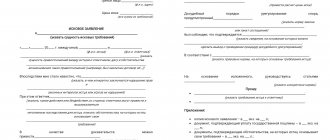The concept of recognition of a claim
According to Part 1 of Art. 39 Code of Civil Procedure, Part 3, Art. 49 APC and part 3 of Art. 46 CAS RF, the defendant, represented by the defensive party, has the unconditional and subjective right to admit the claim, that is, to unconditionally or partially agree to satisfy the substantive legal requirements of the plaintiff, which are the subject of the dispute. The plaintiff himself is a third party who initiates legal proceedings by filing a claim with the court and asking to protect his rights and legitimate interests.
Confession is the free will of the defendant, and therefore must be carried out voluntarily without any conditions or reservations. Ultimately, it is aimed at ending the legal proceedings by issuing a positive decision for the plaintiff, that is, a decision to satisfy the claim.
In Art. 173 Code of Civil Procedure, clause 9, part 2, art. 153 APC and part 1 of Art. 156 CAS RF notes that the form of recognition of a claim is of two types:
- Written statement
. Once compiled in proper form, it is presented to the court during the court hearing and attached to the case materials. Unlike a complaint, such a statement is not associated with a violation of legitimate interests and rights, and therefore does not contain a request to eliminate them. It is aimed only at realizing the interests and rights of the applicant. - Oral confession
. The defendant may also make an oral statement regarding the recognition of the claim. In this case, his words are recorded in the minutes of the meeting and confirmed by signature.
If a party admits a claim outside a court hearing, then this action will have no legal significance.
If the defendant simply remains “silent” (does not send an objection to the statement of claim, skips court hearings, does not form his own position in any way), this does not automatically mean that he agrees with the recognition of the claims, but may entail a decision to satisfy them .
Read the following article about how to behave correctly in court.
The right to recognition of a claim is administrative in nature. This means that if the court has no doubts about the credibility and free will of the defendant, the case under consideration will be completed by issuing a decision. There will be no proceedings on it, which fits into the norms specified in Part 3 of Art. 68 and paragraph 2, part 4, art. 198 Code of Civil Procedure of the Russian Federation. In fact, the recognition of the defendant is a sufficient basis for the legislator to satisfy the demands of the plaintiff, and in the reasoning part of his decision to indicate only the recognition of the claim and its acceptance.
A similar principle is also enshrined in paragraph 1 of Art. 9 GK. It notes that, at their own discretion, citizens and legal entities can dispose of the rights that belong to them (at their own will and in their interests). In this case, administrative actions belong exclusively to the parties to the paperwork and persons equated to them. The latter may be third parties who make independent claims. These powers cannot be interfered with by other entities, including the court.
Change of claim
The right to amend a claim means a legally defined opportunity for the plaintiff
- change the subject or basis of the claim,
- increase or decrease the amount of claims.
According to Art. 39 of the Code of Civil Procedure of the Russian Federation, the plaintiff has the right to change either the subject or the basis of the claim, and not both elements together. A change in the cause of action may be caused by the fact that the plaintiff referred to circumstances that cannot substantiate the stated requirements. As for the subject of the claim, if the plaintiff’s demand is formulated erroneously and does not correspond to the legal structure of the legal relationship provided for by law, then the plaintiff is given the opportunity to change the demand, preserving the basis of the claim.
A simultaneous change in both the subject and the basis of the claim essentially means its abandonment.
The general rule is that the court cannot change the subject or basis of the claim without the consent of the plaintiff. At the same time, the court may go beyond the stated requirements in cases provided for by federal law (for example, the Family Code allows the court, when dividing property between spouses, to go beyond the limits of equality of shares and, taking into account the interests of the children, increase the share of the spouse with whom the children remain) .
Art. 196 of the Civil Procedure Code instructs the court to make decisions on the stated requirements. The right to change the subject of the claim belongs to the plaintiff, not the court. If the plaintiff changed the basis or subject of the claim, increased or decreased its size, the defendant admitted the claim in whole or in part, this should be indicated in the descriptive part of the decision (clause 10 of Resolution No. 23 of the Plenum of the Supreme Court of the Russian Federation of December 19, 2003 “On the Judicial Decision ").
This is interesting: How to sell a plot of land that you own
The right to increase or decrease the amount of claims is used, for example, in a situation where the plaintiff, having determined with a sufficient degree of certainty the correctness of his legal position in the case, demands to recover from the defendant, in addition to the amount of the principal debt, interest for the use of funds or due to the long period of consideration The case asks to collect penalties not on the day the statement of claim was filed, but at the time the decision was made.
A reduction in the size of the claim may mean that the plaintiff realized the incorrectness of his legal position on certain issues (for example, when initially, along with others, a claim for compensation for moral damage was made, and already during the process that arose, the plaintiff realized that the nature of the disputed material legal relations does not provide for such a possibility), as well as voluntary out-of-court satisfaction of part of the demands by the defendant.
Who can write an application?
The legislation determines that a claim can be recognized by both the defendant in the case and his representative, who has the appropriate powers, separately specified in the power of attorney.
It happens that there are several co-defendants. In this case, there should be no contradictions on their part, otherwise they will be interpreted as obstacles to accepting recognition. The presence of a conflict between them in the case may also be evidenced by the absence of a clearly expressed position of representatives on the part of the defendant.
What exactly is the defendant admitting?
The recognition of a claim must be distinguished from the recognition of a fact (Part 2 of Article 8 of the Code of Civil Procedure).
In the second case, the defendant admits only individual facts on which the opposite party relies, but not the claim as a whole, as when admitting a claim. For example, the defendant may admit the fact of a debt to the plaintiff, but at the same time oppose the execution of the claim due to the expiration of the statute of limitations or the unlawful amount of the debt. Under the current circumstances, a dispute arises. In fact, the plaintiff does not have to prove the facts admitted by the defendant, but at the same time in court he will need to hold him accountable. This means that the absence of a fact about a dispute is not classified as an absolute basis for termination of legal proceedings on the merits. Thus, legal proceedings regarding rights can continue without a dispute of fact.
When the defendant admits the claim, he automatically agrees with both the factual circumstances of the case and the claim itself, that is, with its legal classification and legal consequences.
The procedural actions under consideration have different consequences: when recognizing a claim, the court makes a decision to fully or partially satisfy the claim, and when recognizing only facts (circumstances), the plaintiff is simply freed from the need to prove them during legal proceedings.
In practice, it also happens that the defendant expresses his agreement with the claims, but does not intend to admit them. In this case, we are not talking about recognition of the claim, since the defendant only states his position on the case.
To whom is the application addressed?
Recognition of a claim as an administrative action is always addressed to the court, therefore a written statement from the defendant must be communicated to it according to the rules established by Part 1 of Art.
173 Code of Civil Procedure. It is important that the defendant clearly express his will in a separate statement. Its recognition should not follow from other actions and documents, since it is an independent procedural action, implemented independently of others. In this regard, if the defendant agreed with the substantive legal requirements of the plaintiff, for example, only in a written response to the claim, then this cannot be classified as an admission of the claim, and therefore will be considered by the judicial body along with other evidence when resolving the case on the merits.
Thus, if the confession is correctly formalized in the application and there are no grounds for refusal, the court will definitely accept it. From a theoretical point of view, the court intervenes in the distributive actions of the parties only to ensure compliance with legal norms and protection of the interests of third parties. In other cases, the parties implement their own rules without restrictions or any third-party interference.
In what cases is the application made?
In order to peacefully and quickly end the legal process in favor of the plaintiff, the defendant often submits an application to the court for recognition of the claim.
This allows him to save time and material resources in an obviously losing business. Such cases are extremely rare in practice, since most lawyers recommend refraining from this procedure even if there is the slightest likelihood that the proceedings could end in his favor.
Meanwhile, there are still circumstances when the participants in the trial want to speed up the process, so they agree among themselves to satisfy all requirements. In such a case, a good option is for the defendant to file a declaration of recognition of the claim. In it, he notes that he fully or partially agrees with the plaintiff’s demands and is ready to satisfy them.
Registration regulations
The legislative acts of the Russian Federation do not strictly establish the requirements that are recognized by the defendant during the trial. However, there are rules on the basis of which minutes of a court hearing must be drawn up. Before announcing the final verdict on granting the refusal, the judge often takes as a basis the current practice of the courts, as well as decisions of higher authorities.
Registration of partial consent
Partial consent can be provided in two ways:
- All points with which the defendant agrees must be communicated orally. They must be included in the court record, which is kept by the court secretary. After which the defendant, who has agreed to part of the terms, must sign and date it.
- The defendant prepares a statement of recognition of the claim in advance, which is attached to the case materials. The application for recognition of the claim by the defendant must clearly and clearly set out all the conditions with which he agrees. As well as the conditions that the judge will study in the future. If the application for recognition of the claim is of a material nature, then the citizen must indicate the amount with which he agrees. And also the amount that he refuses to pay.
Note! If the interests of the defendant are represented by a lawyer, then he can carry out this procedure. However, to do this, he must have a power of attorney to perform such actions.
The procedure for drawing up an application and its sample
When a confession is made in writing, the defendant writes a statement, while complying with the usual legal requirements.
standard document form in .doc (Word) format In a standard application for recognition of a claim, in addition to the required information, you must provide information about why the defendant recognizes the legitimacy of the plaintiff’s demands and wants to satisfy them. Additionally, it should be noted that the relevant norms of the Code of Civil Procedure of the Russian Federation are clear, and the applicant is aware of the consequences of filing a request for recognition of the claim. If a document is drawn up and submitted by a representative, then such a right must be specified in a separate power of attorney to carry out such actions. To accurately put on paper all the necessary information, the applicant should proceed in the following order:
- In the upper right corner (header) indicate the name of the court where the application will be sent, as well as the full name and address of the parties (defendant, plaintiff).
- On the white line, in the central part, indicate the name of the document (“Application”), and at the bottom add the phrase “on the recognition of the claim by the defendant.”
- Draw up the contents of the appeal, in which you state what claim the case is being processed for, and what exactly the plaintiff demands from the defendant. The applicant must note that he considers the demands of the opposite party to be justified, therefore they are recognized in full or in part.
- Please note that the provisions of Art. 35, 39 and 173 of the Code of Civil Procedure of the Russian Federation is known. Thus, the applicant confirms that his recognition complies with legislative norms, does not violate the rights and legitimate interests of third parties, and, if accepted by the court, obliges him to satisfy the claims.
- Insert the date of the application and signature.
By following this order, you can make a competent statement.
sample application in .docx format (Word)
In addition to the application in several copies, you can write a request to include it in the case materials.
Application for recognition of conditions. Design algorithm
A standard sample application for recognition of a claim by a defendant can be easily found on the Internet. Examples of documents are also available on information boards in the courthouse. You can get a sample from a lawyer.
The application for recognition of the claim by the defendant must contain the following information:
- Personal data about the parties to the dispute, their addresses.
- The name of the document is centered in the text.
- Information about the proceedings, its number, the reasons why the defendant agreed to the conditions.
- Requirements with which the citizen agreed and their size.
- A message that the defendant is aware of the consequences associated with consent.
- Date and signature of the applicant.
Consideration of the application in court
An application for recognition can be submitted by the defendant to the court at any stage of the legal process - from the moment the claim is accepted for proceedings, at the preliminary or main court hearing until the decision is made. It is considered in the same manner as a complaint:
- After filing, the application is attached to the case file. A corresponding entry about this is made in the minutes of the court session.
- The court explains to the participants in the case the consequences of recognizing the claim and notes that it is the basis for the court to perform a procedural action. The relevant norms are given in Part 2 of Art. 173 Code of Civil Procedure and Part 2 of Art. 157 CAS RF. The Arbitration Procedure Code says nothing about a similar requirement.
- The court finds out whether the defendant’s confession is really his free will, exercised by him as a subjective right. To do this, he studies the materials previously provided for review, which contain an indication of the circumstances of the dispute, and gives them an appropriate assessment. In addition, the judicial body conducts a survey of the defendant, during which it finds out and checks the following factors:
- are there any conditions for recognizing the claim;
are there any grounds that force the defendant to commit such an action;
- whether the applicant has been diagnosed with illnesses that prevent him from understanding the significance of the procedural actions being taken;
- whether the defendant understands the content of the claims and is ready to take the consequences for such a decision.
- The court pays more attention not to the motives for such a confession, but to the extent to which the defendant is aware of the consequences of his action. Along with this, the judicial body determines whether the recognition complies with the law and whether it takes into account the interests of outsiders. As a rule, additional questions arise in disputes about challenging paternity, division of property in the presence of minor children, etc. In these cases, the defendant needs to prove that his confession does not harm the interests of other persons.
- If the court determines that the defendant’s action is not his free will, is contrary to the law or violates the rights of third parties, it refuses to accept recognition of the claim.
In particular, the court does not have the right to accept recognition of the claim if it was made by a lawyer appointed by him as the legal representative of the defendant on the basis of Art. 50 GPC. This may violate not only the will of the defendant, but also his rights. The court also does not accept a confession in cases where it has reason to believe that it was made to conceal the actual circumstances of the case or under the pressure of deception, violence, threats, or delusions. The law does not establish specific circumstances, therefore, in each individual case, the issue of recognizing a claim is decided individually. - The court makes a decision on refusal in the ruling and continues consideration of the case on the merits in the usual manner.
However, in most cases, the proceedings end with the court accepting the will of the defendant, on the basis of Part 4 of Art. 198 Code of Civil Procedure and clause 3, part 4, art. 170 of the APC records this circumstance in the reasoning part of the decision and makes a decision to satisfy the plaintiff’s demands without analyzing the evidence base. If the application is reviewed positively, a decision in the civil case will most likely be made as soon as possible.
All questions from the judicial body and the applicant’s answers must be noted in the minutes of the meeting.
Acknowledgment of the claim by the defendant in court.
Acknowledgment of a claim is the defendant’s agreement with the plaintiff’s stated demands, which, as a rule, leads to a decision to satisfy the claim.
Recognition of a claim by the defendant can be made in court for various reasons: the unfoundedness of the defendant’s objections and (or) conviction of the fairness of the plaintiff’s demands, the defendant’s complete or partial voluntary renunciation of his subjective right in favor of the plaintiff, unwillingness to continue the dispute, and others.
Recognition of a claim in court: general provisions
Acknowledgment of a claim is distinguished by form and content. In form, it can be a separate written statement by the defendant or oral.
The acknowledgment of the claim, formalized by a statement in writing, is attached to the case, as indicated in the minutes of the court session. An acknowledgment of the claim, stated orally by the defendant, is entered into the minutes of the court session. The entry in the minutes of the court session is confirmed by the signature of the defendant.
In any case, the defendant's oral or written statement of recognition of the claim must be brought to court. Therefore, if the defendant expressed agreement with the substantive legal requirements of the plaintiff, for example, only in a written response to the claim, such a document will not constitute an admission of the claim, but must be assessed by the court along with other evidence when resolving the case on the merits.
In terms of content, it can be complete or partial, simple or qualified. If the claim is partially recognized, the substantive dispute remains in that part of the plaintiff’s claims that is disputed by the defendant.
Simple recognition - unconditional agreement with the claim.
Qualified, on the contrary, is always done with reservations that do not allow the plaintiff’s claim to be considered indisputable. For example: the defendant in court admits the existence of a loan agreement between him and the plaintiff, but claims that he returned the requested amount without receiving a receipt from the plaintiff confirming the return of funds.
Recognition of a claim should be distinguished from recognition by a party of the circumstances on which the other party bases its claims or objections (Part 2 of Article 68 of the Code of Civil Procedure of the Russian Federation). For example: the defendant acknowledges the conclusion of the transaction, but does not recognize the amount of debt required by the plaintiff.
Acknowledgment of a claim, as a unilateral action of the defendant, should also be distinguished from a settlement agreement. In this regard, the parties to the process should be careful when drawing up their agreements.
For example: if, according to the terms contained in the settlement agreement, the defendant fully and unconditionally acknowledges the plaintiff’s demands and undertakes to repay the existing debt to the creditor in the amount of the claim price, formalizing such an action in a settlement agreement seems erroneous due to its obvious unilateral nature.
If the rights and legitimate interests of the defendant are defended in court by his representative and the defendant does not personally take part in the process, it should be taken into account that the recognition of the claim relates to individual procedural actions, which, in order for them to be carried out by the representative in court, must be specifically stipulated in the power of attorney.
Consequences of admitting a claim
The recognition of the claim is assessed by the court in conjunction with all the materials available in the case and taking into account the circumstances of the case clarified during the trial.
The voluntariness of the actions is determined by interviewing the defendant. During such a survey, the court determines: the presence or absence of conditions for recognizing the claim; the absence of circumstances that force the defendant to admit the claim; the presence of diseases that prevent understanding the meaning of procedural actions; understanding the meaning of the content of the claims and the consequences of the procedural action.
If the defendant recognizes the claim and accepts it, the court makes a decision to satisfy the claims made by the plaintiff. The reasoning part of such a court decision can only indicate the recognition of the claim and its acceptance by the court.
This is interesting: Settlement agreement on division of property
The court does not accept this action if it contradicts the law or violates the rights and legally protected interests of other persons (Part 2 of Article 39 of the Code of Civil Procedure of the Russian Federation). If the recognition of the claim by the defendant is not accepted by the court, a ruling on this is made and the consideration of the case on the merits continues.
Please note: as changes in the legislation of the Russian Federation are released and come into force, some of the information provided on this page may be outdated and no longer applicable.
Consequences of approval of the application
The defendant must understand the consequences of admitting the claim. They must be explained by the court. These include:
- consent to satisfy the claims made by the plaintiff (part 3 of article 173 of the Code of Civil Procedure, part 2 of article 304 of the CAS);
- recognition of the facts that the opposing party puts forward to substantiate its claims or objections (this means that these facts will be accepted by the court without the need to prove them on a general basis);
- loss of the opportunity to withdraw the application for recognition of the claim if the court did not commit procedural violations (the defendant can only appeal the judge’s decision, but will have to justify the reasons for filing the application with the court of first instance, for example, threats, incapacity, etc.);
- it is no longer possible to go to court in this case, since the dispute under consideration will be considered resolved in favor of the plaintiff);
- the opportunity to conclude a settlement agreement if the defendant does not agree with any point of the decision.
If the defendant wishes to agree with the substantive legal requirements of the plaintiff, he can file an application with the court for recognition of the claim in part or in full. This event is considered legally significant and is classified as an administrative action.





